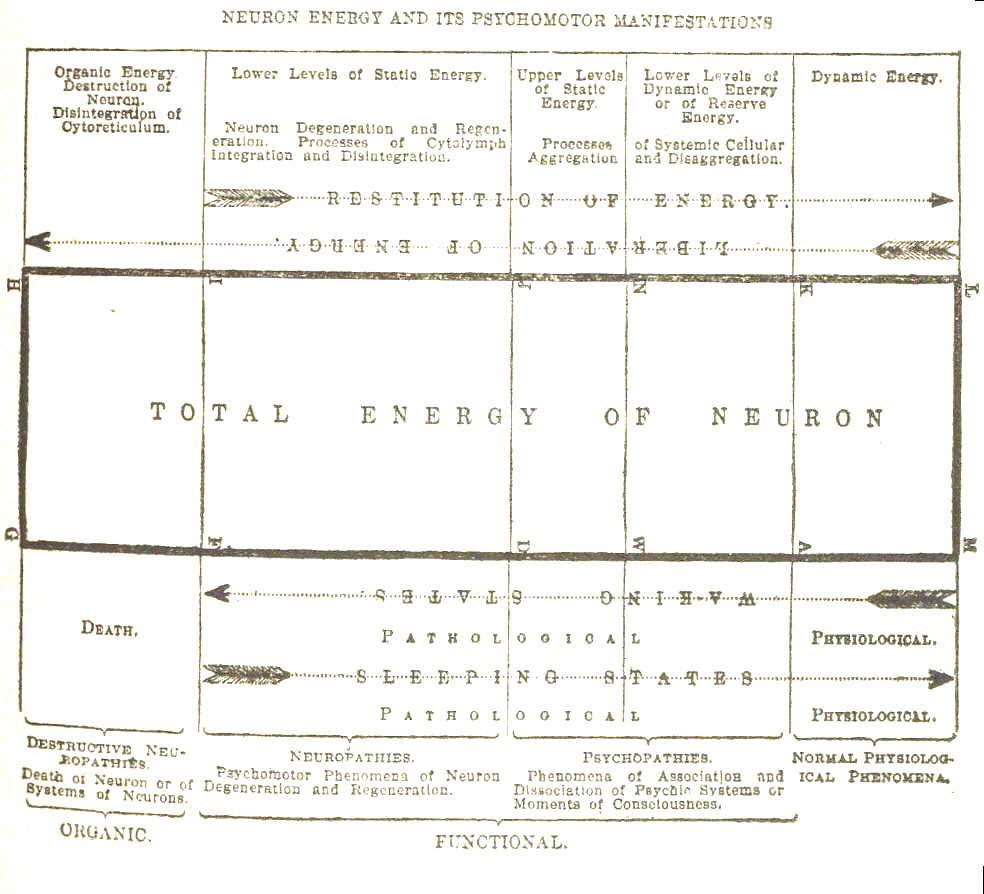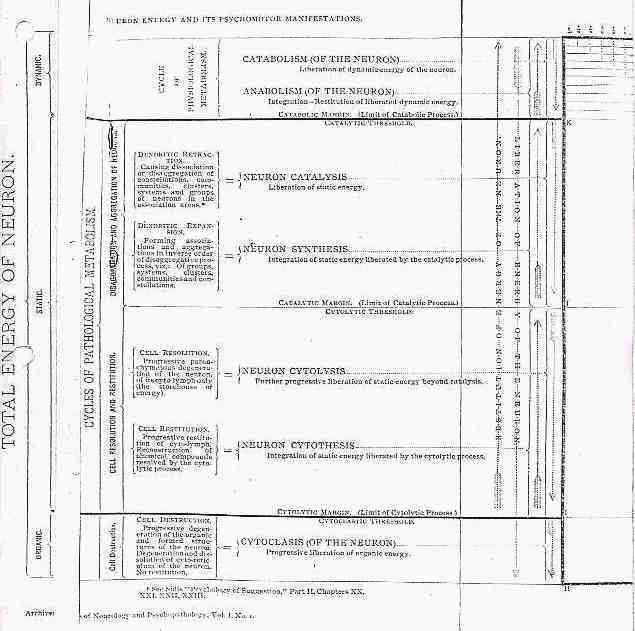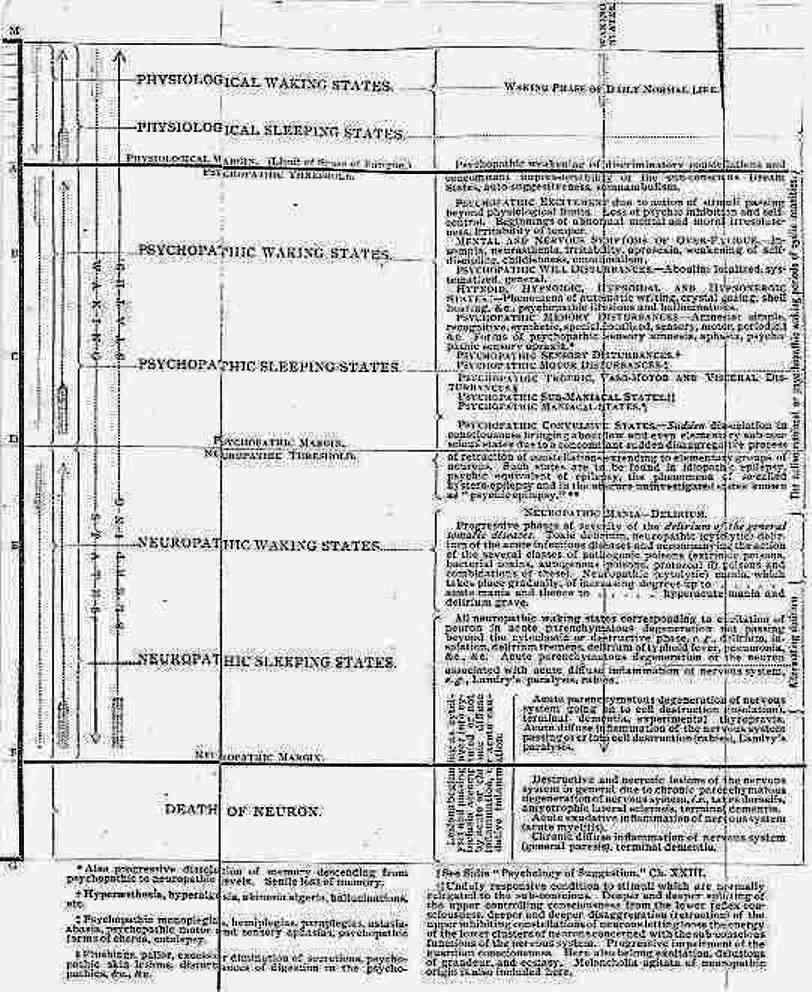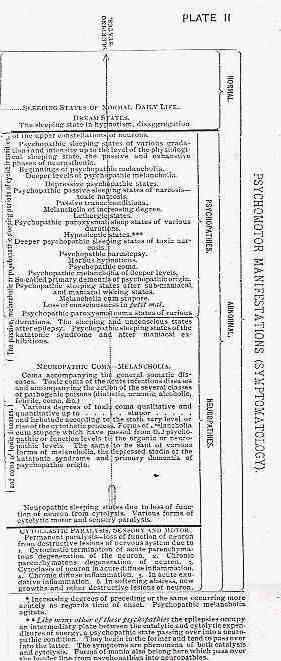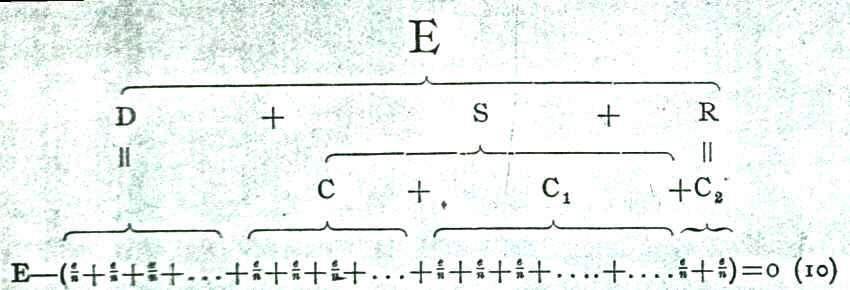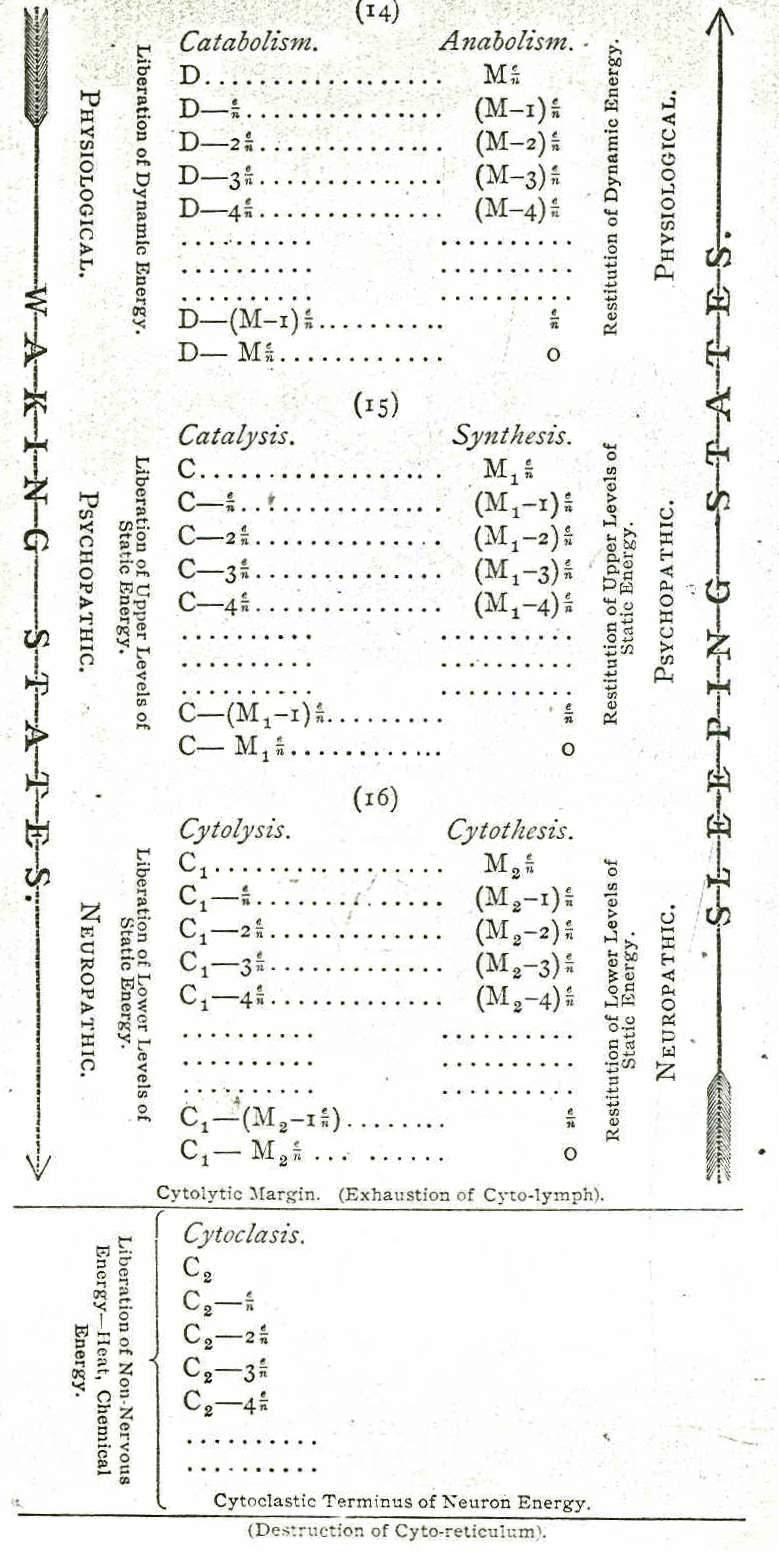| Home
Boris
Sidis Archives Menu
[Note: Sidis in later life summarized his
theory of neuron energy in Symptomatology, Psychognosis, and
Diagnosis of We intend here to set forth in a concrete diagrammatic form a theory that attempts to correlate the various general manifestations of psychomotor life with more or less definite physiological processes depending on the expenditure or restitution of neuron energy. If this theory were perhaps to open some new lines in the study of abnormal mental and neural manifestations, or if only to stimulate a reconsideration of some of the old problems, its publication is not inappropriate. In the first plan (Plate I), the parallelogram G M L H represents the total energy of the neuron. This total energy of the neuron is divided into three phases, viz.: Dynamic, Static, Organic.
PLATE I Static energy may in turn be divided into two phases according to the nature of the process of liberation of neuron energy. As long as the process of liberation of energy effects only a dissociation of systems of neurons the correlative psychomotor manifestations fall under the category of psychopathies. If, however, the process of liberation affects the neuron itself, bringing about a disintegration of its constituent parts compatible with restitution, the correlative psychomotor manifestations fall under the category of neuropathies. This process of disintegration, equivalent to cell degeneration in the patho-anatomical sense, may end in death, in the dissolution of the neuron itself.1 By psychopathies, then, we designate the pathological phenomena of psychic disaggregation correlative with the state or process of dissociation within clusters or constellations of neurons, the neuron itself remaining undamaged.2 By neuropathies, we mean to indicate a group of psychophysical manifestations, running parallel to fluctuations of static energy and accompanied by organic changes in the neuron. We may now turn to the larger and more complete schema. The second chart (Plate II) is a further development of the first plan (Plate I). In it the pathological processes and their psychomotor concomitants are given in more or less provisional detail.
(Click / Tap images to enlarge.) PLATE II The physiological processes and corresponding psychomotor manifestations in the fluctuations of the dynamic energy hardly need, in the present communication, any further explanation, except possibly to indicate that dynamic energy is represented as expended and recruited by small or possibly infinitesimal differentials and increments. This is indicated by the parallel lines drawn across the rectangle representing dynamic energy, this energy falling or rising to different levels. Each of these increments is indicated by a fraction of the total energy, represented by the numerator e and the denominator n. The energy is assumed as drawn off, or recruited at any part of the whole rectangle by nths of the total amount. Passing across the border line A K of the cyclic fluctuations corresponding to physiological metabolism constituted by the process of catabolism and anabolism, fluctuations in the upper levels of the static energy of the neurons, are met with. Here we step over the catalytic threshold. The physical process occurring in the neuron, corresponding to these changes in the upper levels of the static energy, are no longer physiological but pathological, and corresponds to catalysis and synthesis. Catalysis corresponds to liberation of the upper levels of static energy, and is accompanied by retraction of aggregates of neurons, bringing about the phenomena of psychophysiological dissociation. Restitution of the energy expended in the catalytic process is accompanied by expansion or synthesis of the neurons which are again able to transmit or receive impulses in the particular aggregate to which they belong.3 An arrest or halt after the expenditure of energy in these upper static levels, corresponds again to a state of retraction of the neuron or catalysis.4 On the right-hand side of the diagram, concomitant with the processes of catalysis or synthesis of the neuron, we find corresponding states of psychic disaggregation and aggregation: psychopathic waking states or states of mental dissociation going hand in hand with catalysis, and psychopathic sleeping states with the process of synthesis. In the second column, on the right-hand side of the diagram, a general outline is given of the detailed manifestations of the psychopathic waking states. These are given in the sequence in which they occur, as far as we can determine in the present writing, according to the progression of catalytic processes passing from the very highest constellations of neurons which the nervous system possesses, down through lower and lower associations and finally into groups of neurons.5 In the third column to the right of the central rectangle in the diagram are given some of the specific manifestations of the neuron associations during the psychopathic sleeping state, in the upper levels of static energy have reached the maximum of their expenditure, and ascend toward the normal physiological level by the process of restitution of energy. These cycles in the rise or fall of energy are always indicated by the direction of the smaller arrows on either side of the central rectangle, representing the total energy of the neuron. Psychopathic manifestations correspond to the processes of catalysis and synthesis of the neurons, or to an arrest in the liberation of energy after catalysis has progressed to a certain degree. Passing now beyond the catalytic margin in the expenditure of static energy of the neuron, we may consider the further expenditure of static energy. Here we step over the catalytic threshold. The pathological process corresponding to expenditure of the levels of static energy beneath the cytolytic threshold is termed cytolysis of the neuron, which means cell resolution. At this point organic and structural changes are found in the neuron, more particularly in the character of the cytolymph.6 We have here the initial stages of the process of neuron degeneration, and the term cytolysis indicates such phases of parenchymatous degeneration of the neurons which may lead either to restitution or destruction. Cytolysis, therefore, embraces the phases of organic degeneration of the neurons up to, but not beyond the borderline of destruction in the process of this degeneration. The regeneration of theses degenerative changes in the call, not overstepping the limits of destructive alterations in the neuron, is termed cytothesis. It is the reverse of cytolysis. Corresponding again to the pathological processes of cytolysis and cytothesis, going hand in hand with fluctuations in the lower levels of static energy, are the concomitant neuropathic waking and sleeping states with their psychomotor manifestations. Broadly speaking, psychopathies run parallel to the phenomena of retraction and expansion of aggregates of neurons, while neuropathies are concomitant with actual degeneration of the neuron, especially of its cytolymph. The expenditure of organic energy is accompanied with cell-destruction or cytoclasis.7 Cytoclasis is the destructive outcome of degeneration of the neurons―parenchymatous degeneration of the nervous system, acute or chronic. This can be neither sleeping nor waking states below the cytolytic margin, as the neuron is dead.8 In setting down the specific symptomatic expressions of the several psychopathic and neuropathic sleeping and waking states, it is impossible, in many instances, to draw sharp lines of division between the two sets. They are necessarily put down in a general way, and more or less provisionally as an attempt to analyze psychomotor phenomena manifested in abnormal nervous and mental life on a tangible basis of fluctuations of neuron energy. The difficulty of sharply defining abnormal waking and sleeping states lies in the fact that in the same individual one part of the nervous system is in the process of restitution and is in a sleeping state, while another portion is in the process of expending energy and is in a waking state. The reader should also be guarded from receiving the impression that sleeping stadia of the nervous system necessarily go hand in hand with a progressive upward rise of the process of energy restitution. It is always to be remembered that the downward process in the liberation of energy is not necessarily followed by the opposite cycle of restitution of energy. The process may halt, or, strictly speaking, oscillate, at some particular level, as at B, C, or D, (in the central rectangle) when a sleeping state is liable to predominate, because from the very nature of pathological metabolism the ascending processes are slower in their course than the descending processes. The liberation process may then, without rising, descend to a still deeper level, as at E. It may then rise to C, and fall back to D, and so on through an almost indefinite series of halts,―upward and downward fluctuations. This ought to make clear our perception of the progression of the sleeping and waking states. Thus, the pathological process and symptoms concurrent with the expenditure of successive levels of static energy may descend and continually go down deeper into the psychopathic and neuropathic realms of psychomotor manifestations. Finally, the descent may be so great that the liberation of energy corresponds to the destruction of the nerve cell, and the disease becomes permanent. The earliest manifestations of general paresis, for instance, are those corresponding to the liberations or restitutions of the uppermost levels of static energy, but finally the process of liberation reaches such a depth that the disease becomes destructive. Psychopathies may therefore become neuropathies, and neuropathies may in their turn progress to the cytoclastic type and result in an absolute and irrevocable loss of function of the neuron.9 The fluctuations of energy again may be such as to take a pronounced alternating or cyclical type, and herein, we believe, is a rational explanation of the circular insanities. The active periods of the circular insanities belong to waking states, and the passive periods are sleeping states of the nervous system. This holds true not only of psychopathic, but also of neuropathic circular states―states of alternating delerium and coma as are found in the acute general somatic diseases that involve the nervous system. The active delerium is placed on the side of the vertical line to be included in the neuropathic waking states, and the passive or comatose alternation of the neuropathic psychic manifestations is set down among the neuropathic sleeping states. It should be remembered that the psychopathic cyclic insanities may not at all remain fixed where they begin in the psychopathic realm, they may descend into the neuropathic domain. In the consideration of this second chart in general, it is always to be held in mind that the order in which these phenomena are set down in the psychopathic and neuropathic states is an order both serial and progressive and no particular set of symptoms is to be considered as fixed in this scale, except as to its course and origin. Thus psychopathic may descend into neuropathic walking states and these again into the domain of destruction of the nerve cell. On the other hand, neuropathic sleeping states may rise to the level of psychopathic sleeping states. Cytoclastic states, however, cannot rise, there can be no restitution because the neuron is destroyed. If any recovery from cytoclasis does occur, it is because of a compensatory action of other neurons and an education on the part of new neurons to assume the function lost by their destroyed associates. It must be distinctly understood, that while the parenchymatous degeneration associated with these several pathological processes begins as a cytolytic lesion, compatible with restitution and recovery of the neuron, it may pass on the destructive state. No one can say, in treating of these nervous diseases generally, whether they may become cytoclastic or remain cytolytic and susceptible of recovery. The determination of such a question must be sought out in the special conditions of each particular case. Furthermore, the important fact must be kept clearly in mind that various groups and systems of neurons may reach different degrees of disaggregation and degeneration, may be simultaneously in different stages of the one continuous descending pathological process of energy liberation. A community, cluster or constellation of neuron aggregates, A, may be in the upper levels of the psychopathic state; another, B, in the deeper levels of the same state; C and D in different levels of the neuropathic state, while E and F may have descended to the levels of cytoclasis. Such a complexity of phenomena is well illustrated in general paresis. Thus the fact that various systems of neurons are often in different stages of disaggregation or degeneration frequently gives rise to a mixed and complex symtomatology, the malady presenting symptoms (psychomotor manifestations) belonging to different stages in the descending pathological process. The disease, however, may still be characterized as psychopathic, if most of the neuron aggregates are in the psychopathic state; it may be designated neuropathic, if most of the neuron aggregrates are in the neuropathic state; it may be termed cytoclastic, if most of the neuron aggregates involved in the process, have reached the destructive stage of cell degeneration. The symptomatology of psychomotor manifestations may thus vary endlessly, like the figures in the kaleidoscope. The symptomatic side of disease is a function of LOCATION, NUMBER and DEGREE. It depends on the location and number of neuron aggregates involved and on the stage or degree of the descending pathological process. We must be clear in reference to some other points. First, neuron energy may be liberated even in the even in the dynamic and static levels not as psychomotor manifestations, but as heat, electricity, etc. Secondly, the dissipation of organic energy of the neuron takes the form of chemical energy in the dissolution of the bodies composing the cyto-reticulum or in giving rise to heat or electric currents. These two latter forms of energy are of no special interest in connection with psychomotor manifestations, they fall outside the domain of functional energy of the neuron, the subject matter of this communication. This liberation of non-nervous energy from destruction of the cyto-reticulum is the reason of the prolongation of the descending arrow beyond the cytolytic margin. Thirdly, we do not believe that a sleeping state of the nervous system can occur without all antecedent waking state. The patient may not cbme under observation, during this antecedent waking state, and as a matter of fact rarely does in those psychopathic waking stages where the attack is acute and the liberation process is of a very short duration. The active waking state corresponding to liberation of energy, preceding what is supposed to be the primary depressed state, may be sudden, fleeting, unobtrusive, but it must exist. An individual cannot be precipitated into a sleeping state without having gone through an antecedent active or waking state. To complete this chart a whole domain of psychomotor manifestations is requisite, namely, that corresponding to the fluctuations of neuron etergy, containing the mixed phenomena of simultaneous waking and sleeping states. These states, as well as many other conditions, require a careful experimental investigation from the standpoint of our theory. Finally, it should be noted that the division lines, such as lie between the cycles of physiological and the subdivisions of the cycles of pathological metabolism, are rather relative? One process directly and continuously passes over into the other; thus catalysis is the forerunner of cytolysis, and cytolysis may become the forerunner of cytoclasis. All of them, however, are stages in the one continuous process of liberation of neuron energy.10 The various nervous and mental diseases are generally considered as separate things. Each disease is assumed as standing by itself, an independent clinical entity, an "Anundfursichsein." This view is metaphysical, although it would seem that nothing is so far removed from metaphysics as medical science. Now, as a matter of fact, diseases are not entities, but processes. Particular sets of symptoms characterizing different clinical pictures of nervous and mental diseases form stages in the one continuous process of liberation of neuron energy of the specially affected neuron aggregates. This one continuous process of liberation of neuron energy may cover the life of a single individual or may extend over the life-history of many generations. The continuous descending pathological process may spread out in time and space, may, extend over a long duration of time and embrace a great number of individuals. The tide of neuron energy may ebb away gradually, leaving each succeeding generation on a lower stage and deeper level in the continuous process of neuron disaggregation and degeneration, thus giving rise to the different stages and manifestations of congenital degeneracy. Many of the so-called degeneracies and the congenital diseases of the nervous system arise, we believe, in this way, In the higher parts of the nervous system pathological processes begin in catalysis, on further descent pass into cytolysis, and if continued further terminate into cytoclasis. In these regions catalysis, cytolysis, cytoclasis, are the three progressive descending stages in the complete cycle of pathological processes. In the lower and lowermost neural segments, however, pathological processes may lack catalysis and begin in cytolysis. The processes of liberation and restitution of neuron energy may be symbolically represented in the following formulæ: Let D represent the physiological or dynamic energy of the neuron, S its static, and R its organic energy, then D + S + R = E, or total energy of neuron; that is D + S + R = E (1). Let e/n be the differential (see Plate II, rectangle K AM L) liberated by each successive or progressive increment of stimulus, then a progressive series arises, the summation of which will be equal to D, or D - (e/n + e/n + e/n + + e/n + e/n . . . . e/n + e/n) = 0 (2) This represents a progressive descending series in the course of neuron activity of the physiological waking state corresponding to the process of catabolism. If we subtract D or the sum of the descending progressive series from E, or total energy, we have static and organic energies or E - (e/n + e/n + e/n + + e/n + e/n . . . . e/n + e/n) = S + R (3) Having descended and reached S, the process of liberation may continue, but at this point it passes into the regions of pathological waking states. The process of liberation continues in the same way by e/n decrements. Now S may be divided into two separate but continuous series representing two stages of the pathological waking state in the progressively descending scale of liberation of neuron energy. The first series corresponds to catalysis, the second to cytolysis. The process of liberation of organic energy of the neuron R corresponds to cytoclasis. If the static energy liberated by catalysis be designated by C, the energy liberated by cytolysis by C1, and the organic energy set free by cytoclasis by C2, then we have the following formulæ: C - (e/n + e/n + e/n + . . . . . . e/n + e/n) = 0 (4) Catalytic margin. C1 - (e/n + e/n + e/n + . . . . . . e/n + e/n) = 0 (4) Catalytic margin. C2 - (e/n + e/n + e/n + . . . . . . e/n + e/n) = 0 (4) Catalytic terminus. These formulæ express respectively the limits of liberation of energy of the three descending pathological processes. Adding equations (4), (5), (6) together, we have: (C + C1 + C2) – [ (e/n + e/n + e/n + . . . . . . e/n + e/n) + (e/n + e/n + e/n + . . . . . . e/n + e/n) + (e/n + e/n + e/n + . . . . . . e/n + e/n) ] = 0 (7) With the final decrement of equation (5) we reach the functional zero point or cytolytic margin and with the final term of equation (6) we reach the absolute zero point, the terminus of liberation of energy. The cytolytic margin indicates the end of the expenditure of nervous or functional energy; the cytoclastic terminus marks the close of the residual or non-nervous energy of the neuron. The lowest limit in the descending process of energy dissipation is reached at the cytoclastic terminus of the total cell energy. This terminus may be represented in the following formulæ: E – D – S – R = E – D – (C + C1 + C2) = ) (8) or, E – [ (e/n + e/n + e/n + . . . . . . e/n + e/n) + [(e/n + e/n + e/n + . . . . . . e/n + e/n) + [(e/n + e/n + e/n + . . . . . . e/n + e/n) ] = 0 (9) Recapitulating the whole process of the continuous progressive descending series of liberation of nervous energy from the minimum to the maximum limit, we have the following formula:
Each term in the descending series of liberation of functional or nervous energy manifests itself as a waking state, physiological, i.e., catabolic; or pathological, i.e., catalytic and cytolytic, according to the depth of the descent. Having formulated the descending series of liberation of nerve-cell energy, we turn now to the formulation of the process of restitution of energy which takes place, in an ascending series. If in the equation (2) the number of terms be M, the summation of them will give Me/n, then in the complete integration of the ascending series concomitant with the anabolic physiological sleeping state we have: D = Me/n (11) In a similar way we may integrate the pathological series in the ascending scale of restitution, namely, equations (4) and (5). The summation of equation (4) which we may suppose as having M1 terms in the ascending series of the synthetic sleeping state will give us the following formula: C = M1e/n (12) The summation of equation (5) which we may suppose as having M1 terms in the ascending series of the synthetic sleeping state will give us the following formula: C = M1e/n (12) The summation of equation (5) which we may suppose as having M2 terms in the ascending series of the cytothetic sleeping state will give the following formula: C1 =M2e/n (13) The series of cytoclasis cannot be integrated as restitution, from the very nature of the destructive character of the cytoclastic process, is impossible. Thus far we have dealt with complete cycles in the descending scale of liberation of energy concomitant with waking states and the ascending scale of restitution concomitant with sleeping states. Each cycle, however, may be incomplete, may stop and oscillate at any moment in the scale of the series. Thus the ascending process of integration or restitution of energy may be only e/n, or 2e/n, or 3e/n…..or (M – 1)e/n of the expended nervous energy. The restitution of these increments may be characterized as positive and indicated by (+). The same holds true in the case of the process of loss or liberation of neuron energy, it may descend and reach any point in the descending series. The dynamic energy D, for instance, may lose the decrement, e/n, or decrements 2e/n, 3e/n…….. (M – 1)e/n, Me/n, and become D – e/n, D – 2e/n, D – 3e/n……..D - (M – 1)e/n, D – Me/n. These losses or decrements of liberation of energy may be characterized as negative and indicated by (–). Since the descending process of liberation of cell energy is divided into four stages, one merging into the other, namely, the catabolic, the catalytic, the cytolytic and cytoclastic, and since the reverse series of the ascending process is divided into three stages, one passing into the other, namely, the cytothetic, the synthetic and the anabolic, it would be well to co-ordinate these processes and their stages and represent them by the following comprehensive formula:
Formulæ (14), (15) and (16) illustrate the phases of seeming arrests, but really of oscillations in the progression of the processes of liberation or restitution of energy. In catalysis, for instance, liberation of energy may oscillate at the level, C – 1, when a sleeping state may predominate. The catalytic process may then descend to a lower stage of the series, C – 4e/n, and during the descent there is a waking state. If an oscillation occurs at the level, C – 4e/n, a sleeping state again preponderates. Certain cases of cyclical insanity manifesting alternations of waking and sleeping states with slight or no restitution of energy may serve as a case in point. The process of liberation of energy has, slipped from one level to a deeper one, thence to a still deeper level, oscillating for a period at each of these levels. In the same way, in formula (15), in the right hand column of series, corresponding to the synthetic process, we may have a similar symbolical illustration of oscillatory periods in the restitution of energy. The upper levels of static energy in any particular individual may be reduced to the catalytic margin, the process of disintegration may become arrested at this point and the reverse process of synthesis may begin; the process of restitution of energy may rise by e/nths. The recuperation of the energy corresponding to synthesis may rise say to (M1 – 4)e/n (formula 15, right hand column); after oscillating there a while it may rise to a higher level of the series such as (M1 – 1)e/n, and so on until all the upper levels of static energy expressed by the final member of the ascending series, M1e/n, are recovered. The individual has recovered all the upper levels of his static energy and is on the way to become normal; he is about to step across the, border line into the realm of the normal, physiological sleeping state. We may conclude this brief preliminary communication with a few laws relating to the metabolic processes of neuron activity: (I)—Catalysis stands in direct and synthesis in inverse ratio to the number of disaggregated neuron associations. (II)—All other conditions remaining the same, the instability of a cell aggregate is proportionate to the number and complexity of its associative functioning groups.11 (III)—The stability of a neuron aggregate is proportionate to the frequency and duration of its associative activity.12 (IV)—The instability of a neuron aggregate its proportionate to the frequency and duration of the interruptions in its functioning activity.13 (V)—The mass of formed metaplasm granules14 stands in direct ratio to the intensity of cytolysis and in inverse ratio to the progress of cytothesis.
________ 1. Vide Sidis
"Psychology of Suggestion," Ch. XXI, p. 214;
Ch. XXIII, p. 234.
|











